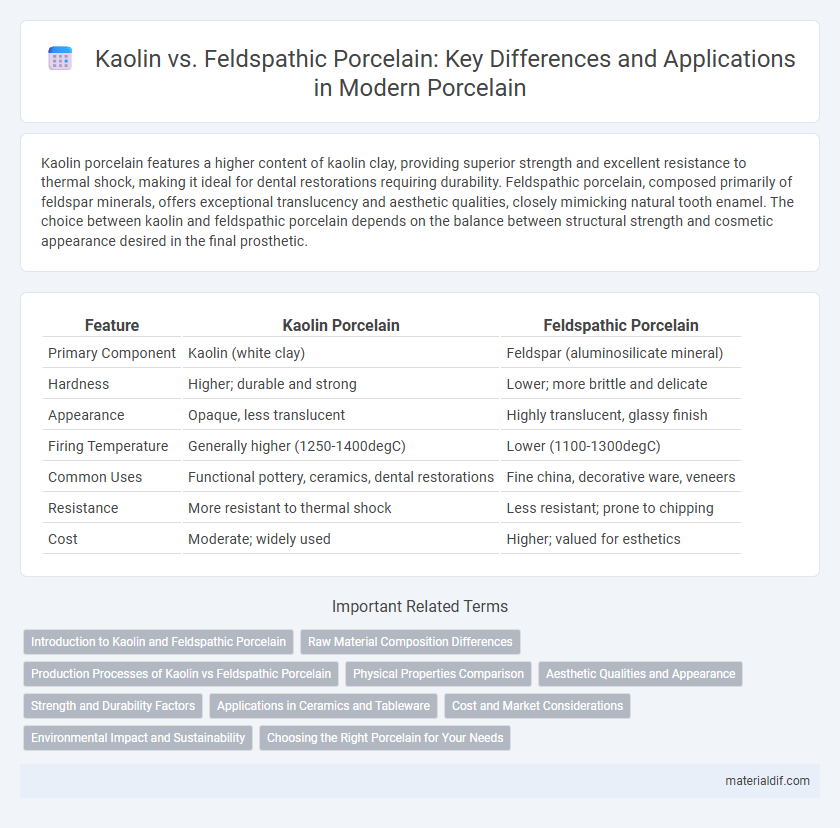Kaolin porcelain features a higher content of kaolin clay, providing superior strength and excellent resistance to thermal shock, making it ideal for dental restorations requiring durability. Feldspathic porcelain, composed primarily of feldspar minerals, offers exceptional translucency and aesthetic qualities, closely mimicking natural tooth enamel. The choice between kaolin and feldspathic porcelain depends on the balance between structural strength and cosmetic appearance desired in the final prosthetic.
Table of Comparison
| Feature | Kaolin Porcelain | Feldspathic Porcelain |
|---|---|---|
| Primary Component | Kaolin (white clay) | Feldspar (aluminosilicate mineral) |
| Hardness | Higher; durable and strong | Lower; more brittle and delicate |
| Appearance | Opaque, less translucent | Highly translucent, glassy finish |
| Firing Temperature | Generally higher (1250-1400degC) | Lower (1100-1300degC) |
| Common Uses | Functional pottery, ceramics, dental restorations | Fine china, decorative ware, veneers |
| Resistance | More resistant to thermal shock | Less resistant; prone to chipping |
| Cost | Moderate; widely used | Higher; valued for esthetics |
Introduction to Kaolin and Feldspathic Porcelain
Kaolin, a primary component of porcelain, is a fine white clay that provides plasticity and structural strength to ceramic bodies. Feldspathic porcelain, composed mainly of feldspar, offers high translucency and a glassy finish due to its fluxing properties that lower the melting point during firing. Understanding the distinct roles of kaolin and feldspathic porcelain is essential for achieving the desired balance between durability and aesthetics in ceramic production.
Raw Material Composition Differences
Kaolin-based porcelain primarily contains kaolinite clay, quartz, and feldspar, contributing to its high strength, translucency, and white color. Feldspathic porcelain is composed mainly of feldspar, quartz, and clay, with feldspar acting as the key flux that lowers melting temperature and enhances vitrification. The higher kaolin content in kaolin porcelain results in increased plasticity and firing stability compared to feldspathic porcelain, which offers superior glassy texture due to its greater feldspar concentration.
Production Processes of Kaolin vs Feldspathic Porcelain
Kaolin porcelain production involves the use of kaolin clay, which is shaped, dried, and fired at high temperatures to develop a dense, durable structure with a white, translucent finish. Feldspathic porcelain production incorporates feldspar minerals, which act as fluxes during firing, lowering the melting point and enabling the formation of a glassy, vitrified matrix that enhances strength and translucency. Both processes require precise control over firing temperature and composition to achieve optimal hardness and aesthetic qualities in the final ceramic product.
Physical Properties Comparison
Kaolin porcelain offers superior whiteness, higher firing temperature tolerance, and enhanced thermal shock resistance compared to feldspathic porcelain, which is more prone to deformation under heat. Feldspathic porcelain exhibits higher translucency and glass content, providing better esthetic qualities but lower mechanical strength and hardness. The physical density of kaolin porcelain generally exceeds that of feldspathic porcelain, contributing to its increased durability and resistance to wear.
Aesthetic Qualities and Appearance
Kaolin porcelain exhibits a bright white and translucent quality, making it ideal for creating fine, delicate dental restorations with high aesthetic appeal. Feldspathic porcelain offers superior translucency and a natural gloss, closely mimicking the optical properties of natural teeth for enhanced visual integration. Both materials deliver exceptional aesthetic outcomes, but feldspathic porcelain is preferred when lifelike appearance and surface texture are critical.
Strength and Durability Factors
Kaolin-based porcelain exhibits higher strength and durability due to its fine-grained structure and higher alumina content, which enhances mechanical resistance and thermal stability. Feldspathic porcelain, composed primarily of feldspar minerals, offers superior translucency but tends to be less durable and more prone to chipping under stress. The balance between strength and aesthetic quality makes kaolin porcelain preferable for applications requiring long-lasting, wear-resistant materials.
Applications in Ceramics and Tableware
Kaolin-based porcelain offers superior whiteness, translucency, and strength, making it ideal for high-end ceramics and fine tableware requiring durability and aesthetic appeal. Feldspathic porcelain, rich in feldspar minerals, provides excellent fusibility and smooth surfaces, commonly used in decorative ceramics and less intensive tableware applications. The choice between kaolin and feldspathic porcelain influences thermal resistance, workability, and final product texture in ceramic manufacturing.
Cost and Market Considerations
Kaolin porcelain tends to be more expensive due to its higher purity and superior whiteness, driving greater demand in premium ceramics and dental applications. Feldspathic porcelain, being more affordable and versatile, dominates the mass market for tiles and pottery where cost efficiency is crucial. Manufacturers often balance cost and quality, choosing kaolin for high-end, niche products while relying on feldspathic porcelain to meet broad consumer demand.
Environmental Impact and Sustainability
Kaolin-based porcelain generally has a lower environmental impact than feldspathic porcelain due to its higher clay content, which requires less energy-intensive processing and firing. Feldspathic porcelain often involves higher extraction and refinement of feldspar minerals, contributing to greater resource depletion and carbon emissions. Sustainable porcelain production prioritizes raw materials like kaolin for their abundance and lower environmental footprint, supporting eco-friendly ceramic manufacturing practices.
Choosing the Right Porcelain for Your Needs
Kaolin porcelain offers superior strength and translucency, making it ideal for fine china and artistic ceramics, while feldspathic porcelain provides excellent glassy texture and is favored for decorative tiles and dinnerware. Selecting the right porcelain depends on balancing durability, aesthetic appeal, and firing temperature requirements specific to your project. Understanding the distinct compositions and properties of kaolin-based and feldspathic porcelains ensures optimal performance tailored to both functional and visual needs.
Kaolin vs Feldspathic Porcelain Infographic

 materialdif.com
materialdif.com